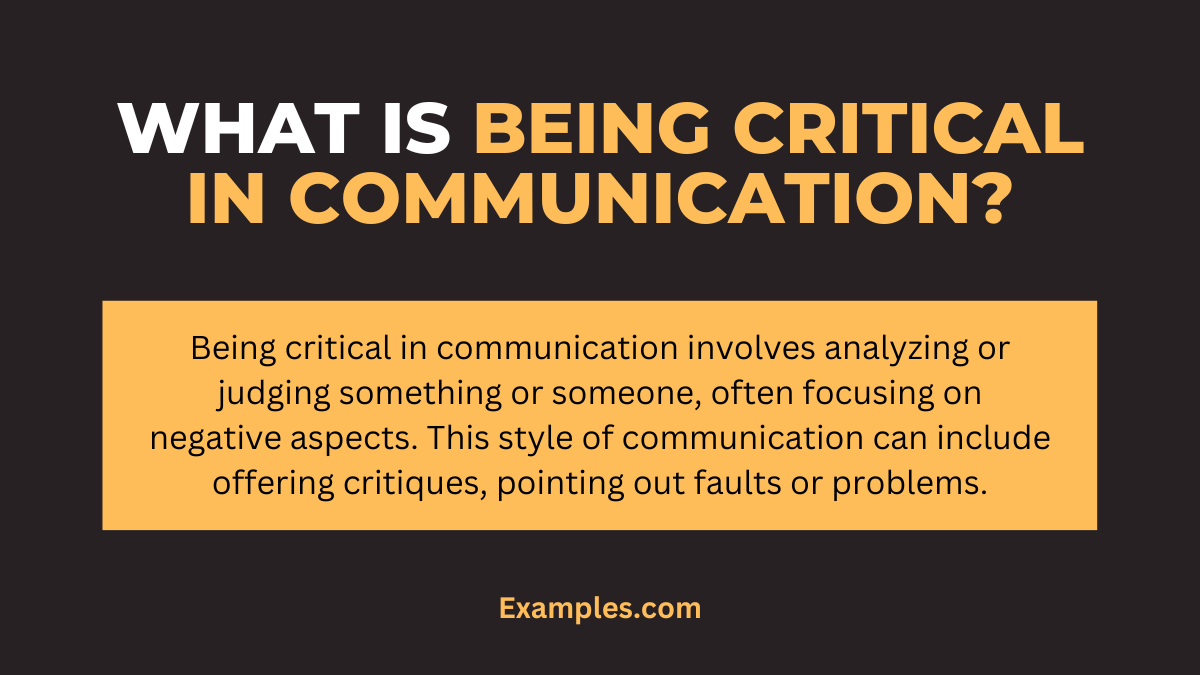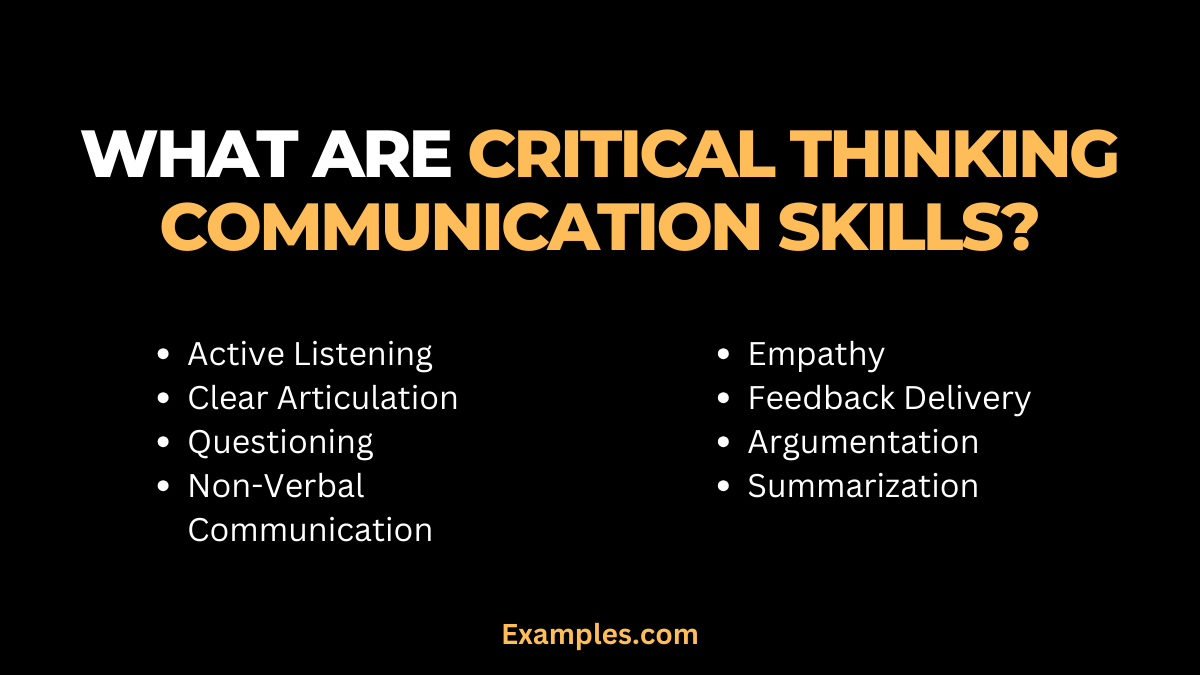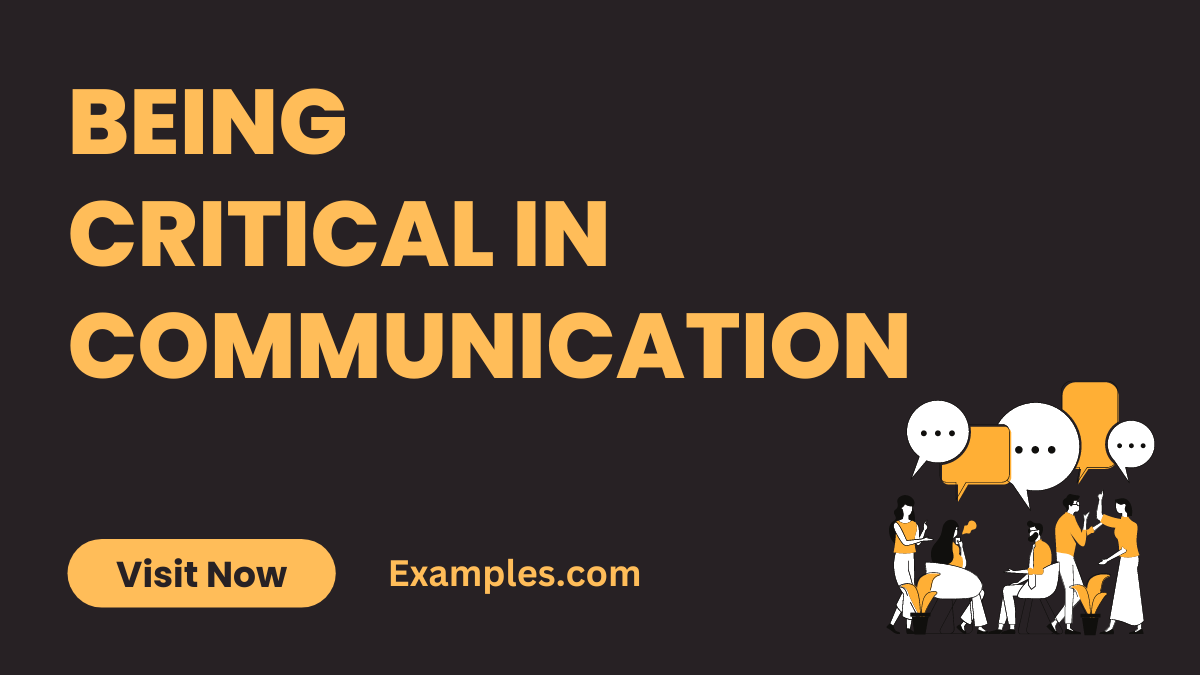19+ Being Critical in Communication Examples
Mastering Being Critical in Communication: This comprehensive guide unveils the art of delivering critical feedback effectively. Filled with practical examples, it teaches how to express criticism constructively, ensuring it leads to positive changes and growth. Learn the nuances of effective communication that foster understanding and respect, even when addressing challenging issues. Perfect for professionals, leaders, and anyone seeking to improve their interpersonal skills. Discover the balance between being honest and empathetic in every conversation.
What is Being Critical in Communication?

Being critical in communication involves analyzing or judging something or someone, often focusing on negative aspects. This style of communication can include offering critiques, pointing out faults or problems, and expressing disapproval. While it can be constructive when done respectfully and thoughtfully, being overly critical can lead to negative interactions and feelings. It’s important to balance critical comments with positive feedback and to ensure that criticism is aimed at improvement rather than merely pointing out flaws.
20 Being Critical in Communication Examples
In communication, being critical involves delivering feedback or opinions that may be perceived as negative or harsh. It’s important to navigate such interactions with sensitivity and empathy, ensuring that criticism is constructive and aimed at fostering improvement rather than causing offense. This article presents 20 examples of being critical in communication, offering insights into how to express critical thoughts effectively. Each example demonstrates the balance between honesty and tact, underscoring the importance of maintaining respectful and productive dialogues.
- “While your report was thorough, it lacked specific examples which could have strengthened your arguments.” This feedback points out a missing element in a colleague’s work, offering a constructive suggestion for improvement.
- “Your presentation was informative, but speaking more slowly and clearly would enhance understanding.” This comment provides constructive criticism on presentation skills, encouraging better delivery for clearer communication.
- “I appreciate your effort in completing the project, but next time, please adhere to the deadlines.” This example balances recognition of effort with the importance of meeting deadlines.
- “Your design is creative, yet it doesn’t align with our brand’s aesthetics.” A critique of a design project, focusing on alignment with brand standards while acknowledging creativity.
- “You have great ideas, but your emails are often too lengthy. Try to be more concise.” Feedback on email communication that encourages brevity for clearer and more effective messages.
- “Your work on the project has been impressive, however, collaborating more with the team could bring even better results.” Encourages teamwork while acknowledging individual contribution.
- “I value your input in meetings, but please allow others to express their views too.” This statement addresses the need for balance in participation during meetings.
- “Your sales pitch was strong, yet a friendlier tone might resonate more with clients.” Suggests a softer approach in sales communication while praising the content.
- “Your analytical skills are excellent, but applying them more practically would benefit the team.” Encourages the practical application of skills in a team setting.
- “You’ve been punctual, but your work sometimes lacks attention to detail.” Balances praise for punctuality with a nudge towards greater thoroughness in tasks.
- “Your enthusiasm is commendable, but it’s important to stay grounded in facts.” Advises a balance between enthusiasm and factual accuracy.
- “While your approach is innovative, aligning it more with our current strategy is necessary.” Encourages innovation within the framework of existing strategies.
- “Your customer interactions are polite, however, showing more empathy could enhance customer satisfaction.” A suggestion to improve customer service through increased empathy.
- “You’re great at starting projects, but focusing on follow-through is equally important.” Points out the need for consistency from initiation to completion of projects.
- “Your writing skills are strong, but using simpler language can make your articles more accessible.” Suggests simplifying language for broader reader accessibility.
- “Your technical skills are unmatched, yet soft skills also play a crucial role in our industry.” Encourages the development of soft skills alongside technical expertise.
- “You excel in individual tasks, but team projects require your active participation as well.” Highlights the importance of teamwork alongside individual excellence.
- “Your risk-taking is admirable, but a balanced approach is key to our project’s success.” Advocates for a balanced approach to risk-taking in projects.
- “You’re a fast worker, but accuracy should not be compromised for speed.” Emphasizes the importance of accuracy over speed in work.
- “Your initiative is impressive, but aligning with the team’s direction is crucial.” Encourages initiative while stressing the importance of team alignment.
Examples of Communication in Critical Thinking for Problem Solving
Effective communication is crucial in critical thinking and problem-solving processes. It involves clear articulation of issues, brainstorming solutions, and collaborative decision-making. This guide focuses on examples that demonstrate how communication plays a key role in identifying, analyzing, and solving problems, especially in team settings or complex scenarios. Emphasizing clarity, openness, and logical reasoning can lead to more effective problem-solving outcomes.
- “Let’s break down the problem into smaller parts to understand it better.” – Encourages analytical thinking by simplifying complex issues.
- “What are the potential causes of this issue? Let’s discuss.” – Initiates a collaborative discussion to explore various causes.
- “Can we think of alternative solutions that we haven’t considered yet?” – Promotes creative thinking and exploring new ideas.
- “What are the pros and cons of this approach?” – Encourages weighing different aspects of a proposed solution.
- “How does this solution align with our overall goals?” – Ensures that the solution is in line with broader objectives.
Why Being Critical is Important in Communication?
Being critical in communication is vital for several reasons. It involves analytical thinking, which is key to understanding complex issues deeply and making informed decisions. Critical communication encourages questioning and exploring multiple viewpoints, leading to a more thorough and balanced understanding of a topic. It also fosters clarity and precision, essential for effective problem-solving and avoiding misunderstandings. Moreover, being critical helps in identifying biases and assumptions, which is crucial for objective and rational communication. Overall, critical communication skills enhance the quality and effectiveness of interactions, whether in personal conversations, professional settings, or academic discussions.
What is the Role of Communication in Critical Thinking?
Communication plays a pivotal role in critical thinking. It involves articulating thoughts clearly, questioning assumptions, and engaging in constructive dialogues to analyze and solve problems. Effective communication allows for the exchange of diverse ideas, promotes understanding, and enables individuals to challenge and refine their thinking. It’s crucial in identifying issues, brainstorming solutions, and making reasoned decisions.
Here’s a deeper look:
- Clarifying and Articulating Problems: Effective communication is key in clearly defining and articulating complex problems, a crucial first step in critical thinking.
- Gathering and Sharing Information: It involves exchanging information, ideas, and insights necessary for thorough analysis.
- Facilitating Discussion and Debate: Encouraging open discussions where various viewpoints are considered is essential for comprehensive evaluation.
- Formulating Arguments: Constructing well-reasoned arguments and counterarguments through communication helps in the evaluation of different perspectives.
- Decision Making: Effective communication is vital in presenting and weighing the outcomes of various solutions, leading to informed decision-making.
- Feedback Incorporation: Communicating feedback effectively allows for continuous improvement in the critical thinking process.
Thus, communication is not just a tool for expressing thoughts but a vital component of the critical thinking process.
What are the Critical Thinking Communication Skills?

Critical thinking communication skills include a range of abilities essential for effective problem-solving and decision-making They include:
- Active Listening: Being an attentive listener aids in understanding different perspectives and formulating logical responses.
- Clear Articulation: Conveying thoughts clearly and concisely is crucial for effective problem-solving.
- Questioning: Asking insightful questions is key to deeper understanding and challenging assumptions.
- Non-Verbal Communication: Understanding and using non-verbal cues effectively can enhance the understanding of ideas and arguments.
- Empathy: Demonstrating empathy helps in considering and respecting different viewpoints.
- Feedback Delivery: Providing constructive feedback is essential for the growth and development of ideas.
- Argumentation: Constructing and deconstructing arguments logically and respectfully is a core skill.
- Summarization: Being able to summarize discussions accurately helps in maintaining focus on the key issues.
These skills facilitate not only the exchange of ideas but also ensure that the process of critical thinking is collaborative, comprehensive, and effective.
How to Use Being Critical in Communication?
Being critical in communication involves offering constructive feedback, challenging ideas, and encouraging analytical thinking. It’s important to:
- Focus on the Issue, Not the Person: Direct your critiques toward specific behaviors or outcomes rather than personal attributes. This approach helps maintain a positive working relationship and keeps the conversation productive.
- Provide Constructive Feedback: When offering criticism, always pair it with suggestions for improvement. This not only helps the recipient understand the issue but also guides them towards potential solutions.
- Balance Criticism with Positivity: Acknowledge what is being done well alongside areas needing improvement. This balanced approach can motivate rather than discourage.
- Encourage Open Dialogue: Create a culture where feedback is seen as a valuable part of growth and development. Encourage team members to voice their thoughts and concerns openly.
- Be Specific and Clear: When offering criticism, be specific about what needs to be improved and why. Vague critiques can lead to confusion and misunderstanding.
Tips for Improving Critical Communication in the Workplace
- Create a Feedback Culture: Foster an environment where regular, constructive feedback is a norm. This encourages continuous improvement and open communication among all team members.
- Train on Effective Communication: Organize training sessions on how to give and receive criticism constructively. These sessions can provide essential skills for maintaining positive communication.
- Encourage Diverse Perspectives: Create an inclusive environment that values and respects different viewpoints. This diversity can lead to more robust problem-solving and innovation.
- Implement Regular Reviews: Establish a routine of performance reviews where constructive criticism is given in a structured and supportive manner.
- Promote Problem-Solving: Utilize critical communication as a tool for identifying issues and collaboratively finding solutions.
In conclusion, being critical in communication is a delicate art. It requires the balance of honesty and sensitivity. The key is to offer constructive feedback that encourages growth and improvement, rather than causing defensiveness or hurt. Effective critical communication hinges on empathy and respect, ensuring that critiques are delivered in a way that fosters understanding and positive change. By mastering this skill, we enhance both our personal interactions and professional environments, creating a culture of open, productive dialogue.



